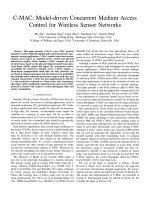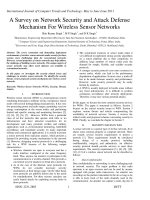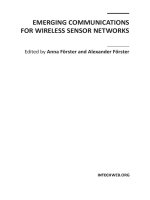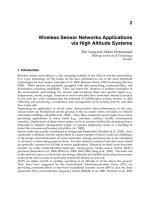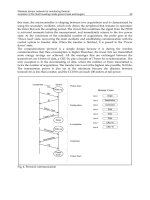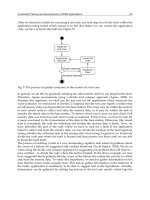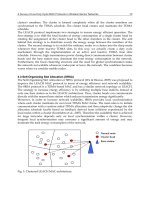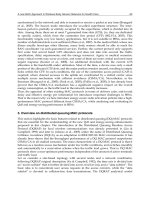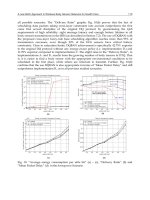Architecture independent programming for wireless sensor networks may 2008
Bạn đang xem bản rút gọn của tài liệu. Xem và tải ngay bản đầy đủ của tài liệu tại đây (11.56 MB, 210 trang )
ARCHITECTURE-INDEPENDENT
PROGRAMMING FORWIRELESS
SENSOR NETWORKS
Amol B. Bakshi
University of Southern California
Viktor K. Prasanna
University of Southern California
WILEYINTERSCIENCE
A JOHN WILEY & SONS, INC., PUBLICATION
This Page Intentionally Left Blank
WILEY SERIES ON PARALLEL AND DISTRIBUTED COMPUTING
Series Editor: Albert Y. Zomaya
Parallel and Distributed Simulation Systems / Richard Fujimoto
Mobile Processing in Distributed and Open Environments / Peter Sapaty
Introduction to Parallel Algorithms / C. Xavier and S. S. lyengar
Solutions to Parallel and Distributed Computing Problems: Lessons from
Biological Sciences / Albert Y. Zomaya, Fikret Ercal, and Stephan Olariu (Editors)
Parallel and Distributed Computing: A Survey of Models, Paradigms, and
Approaches / Claudia Leopold
Fundamentals of Distributed Object Systems: A CORBA Perspective /
Zahir Tari and Omran Bukhres
Pipelined Processor Farms: Structured Design for Embedded Parallel
Systems / Martin Fleury and Andrew Downton
Handbook of Wireless Networks and Mobile Computing /
Ivan Stojmenovic (Editor)
Internet-Based Workflow Management: Toward a Semantic Web /
Dan C. Marinescu
Parallel Computing on Heterogeneous Networks / Alexey L. Lastovetsky
Performance Evaluation and Characteization of Parallel and Distributed
Computing Tools / Salim Hariri and Manish Parashar
Distributed Computing: Fundamentals, Simulations and Advanced Topics,
Second Edition / Hagit Attiya and Jennifer Welch
Smart Environments: Technology, Protocols, and Applications / Diane Cook
and Sajal Das
Fundamentals of Computer Organization and Architecture /
Mostafa Abd-El-Barr and Hesham El-Rewini
Advanced Computer Architecture and Parallel Processing / Hesham El-Rewini
and Mostafa Abd-El-Barr
UPC: Distributed Shared Memory Programming / Tarek El-Ghazawi,
William Carlson, Thomas Sterling, and Katherine Yelick
Handbook of Sensor Networks: Algorithms and Architectures /
Ivan Stojmenovic (Editor)
Parallel Metaheuristics: A New Class of Algorithms / Enrique Alba (Editor)
Design and Analysis of Distributed Algorithms / Nicola Santoro
Task Scheduling for Parallel Systems / Oliver Sinnen
Computing for Numerical Methods Using Visual C++ / Shaharuddin Salleh,
Albert Y. Zomaya, and Sakhinah A. Bakar
Architecture-Independent Programming for Wireless Sensor Networks /
Amol B. Bakshi and ViMor K. Prasanna
This Page Intentionally Left Blank
ARCHITECTURE-INDEPENDENT
PROGRAMMING FOR WIRELESS
SENSOR NETWORKS
This Page Intentionally Left Blank
ARCHITECTURE-INDEPENDENT
PROGRAMMING FORWIRELESS
SENSOR NETWORKS
Amol B. Bakshi
University of Southern California
Viktor K. Prasanna
University of Southern California
WILEYINTERSCIENCE
A JOHN WILEY & SONS, INC., PUBLICATION
Copyright 0 2008 by John Wiley & Sons, Inc. All rights reserved
Published by John Wiley & Sons, Inc., Hoboken, New Jersey
Published simultaneously in Canada
No part of this publication may be reproduced, stored in a retrieval system, or transmitted in any
form or by any means, electronic, mechanical, photocopying, recording, scanning, or otherwise,
except as permitted under Section 107 or 108 of the 1976 United States Copyright Act, without
either the prior written permission of the Publisher, or authorization through payment of the
appropriate per-copy fee to the Copyright Clearance Center, Inc., 222 Rosewood Drive, Danvers,
MA 01923, (978) 750-8400, fax (978) 750-4470, or on the web at www.copyright.com. Requests
to the Publisher for permission should be addressed to the Permissions Department, John Wiley &
Sons, Inc., 11 1 River Street, Hoboken, NJ 07030, (201) 748-601 1, fax (201) 748-6008, or online at
/>Limit of LiabilityDisclaimer of Warranty: While the publisher and author have used their best
efforts in preparing this book, they make no representations or warranties with respect to the
accuracy or completeness of the contents of this book and specifically disclaim any implied
warranties of merchantability or fitness for a particular purpose. No w m n t y may be created or
extended by sales representatives or written sales materials. The advice and strategies contained
herein may not be suitable for your situation. You should consult with a professional where
appropriate. Neither the publisher nor author shall be liable for any loss of profit or any other
commercial damages, including but not limited to special, incidental, consequential, or other
damages.
For general information on our other products and services or for technical support, please contact
our Customer Care Department within the United States at (800) 762-2974, outside the United
States at (317) 572-3993 or fax (317) 572-4002.
Wiley also publishes its books in a variety of electronic formats. Some content that appears in print
may not be available in electronic formats. For more information about Wiley products, visit our
web site at www.wiley.com.
Library of Congress Cataloging-in-Publication Data:
Bakshi, Amol B., 1975Architecture-independent programming for wireless sensor networks / Amol B. Bakshi, Viktor K. Prasanna.
p. cm.
Includes bibliographical references and index.
ISBN 978-0-471-77889-9 (Cloth)
1. Sensor networks--Programming. 2. Wireless LANs--Programming. I. Prasanna Kumar, V. K. 11. Title.
TK7872.D48 B
681'.2--dc22
2007046862
Printed in the United States of America
10 9 8 7 6 5 4 3 2 1
CONTENTS
Preface
xi
Acknowledgments
xv
1 Introduction
1.1
1.2
1.3
1.4
Sensor networks and traditional distributed systems
Programming of distributed sensor networks
1.2.1 Layers of programming abstraction
1.2.1.1 Service-oriented specification
1.2.1.2 Macroprogramming
1.2.1.3 Node-centric programming
1.2.2 Lessons from parallel and distributed computing
Macroprogramming: What and why?
Contributions and outline
1
2
7
7
7
8
10
12
14
16
V
vi
CONTENTS
2 The Abstract Task Graph
2.1
2.2
2.3
2.4
2.5
2.6
Target applications and architectures
Key concepts
2.2.1 Data-driven computing
2.2.1.1 Program flow mechanisms
2.2.1.2 Why data-driven?
2.2.2 Mixed imperative-declarative specification
Syntax
2.3.1 The Structure of an ATaG program
2.3.2 More on task annotations
2.3.3 Illustrative examples
Semantics
2.4.1 Terminology
2.4.2 Firing rules
2.4.3 Task graph execution
2.4.4 get 0 and put 0
Programming idioms
2.5.1 Object tracking
2.5.2 Interaction within local neighborhoods
2.5.3 In-network aggregation
2.5.4 Hierarchical data fusion
2.5.5 Event-triggered behavior instantiation
Future work
2.6.1 State-based dynamic behaviors
2.6.2 Resource management in the runtime system
2.6.3 Utility-based negotiation for task scheduling and resource
allocation
3 DART The Data-Driven ATaG Runtime
3.1
3.2
3.3
Design objectives
3.1.1 Support for ATaG semantics
3.1.2 Platform independence
3.1.3 Component-based design
3.1.4 Ease of software synthesis
Overview
Components and functionalities
21
21
23
23
23
26
28
29
29
34
39
45
45
46
48
48
49
51
52
52
55
56
59
59
61
63
65
65
65
66
67
68
69
72
CONTENTS
3.3.1
3.3.2
3.4
3.5
Task, data, and channel declarations
UserTask
3.3.2.1 Service
3.3.2.2 Interactions
3.3.2.3 Implementation
3.3.3 DataPool
3.3.3.1 Service
3.3.3.2 Interactions
3.3.3.3 Implementation
3.3.4 AtagManager
3.3.4.1 Service
3.3.4.2 Interactions
3.3.4.3 Implementation
3.3.5 Networkstack
3.3.5.1 Service
3.3.5.2 Interactions
3.3.5.3 Implementation
3.3.6 NetworkArchitecture
3.3.6.1 Service
3.3.6.2 Interactions
3.3.6.3 Implementation
3.3.7 Dispatcher
3.3.7.1 Service
3.3.7.2 Interactions
3.3.7.3 Implementation
Control flow
3.4.1 Startup
3.4.2 get 0 and put 0
3.4.3 Illustrative example
Future work
3.5.1 Lazy compilation of channel annotations
3.5.2 Automatic priority assignment for task scheduling
vii
72
75
75
75
77
79
79
79
79
82
82
82
83
87
87
87
87
88
88
88
89
90
90
91
91
93
94
97
100
101
101
102
viii
CONTENTS
4 Programming and Software Synthesis
4.1
4.2
4.3
4.4
Terminology
Meta-modeling for the ATaG domain
4.2.1 Objectives
4.2.2 Application model
4.2.3 Network model
The programming interface
Compilation and software synthesis
4.4.1 Translating task annotations
4.4.2 Automatic software synthesis
4.4.3 The ATaG simulator
4.4.4 Initialization
4.4.4.1 Situatedness
4.4.4.2 Network interface
4.4.4.3 Network architecture
4.4.4.4 Sensor interface
4.4.5 Visualizing synthesized application behavior
5 Case Study: Application Development with ATaG
5.1
5.2
5.3
5.4
5.5
5.6
5.7
Overview of the use case
Designing the macroprograms
5.2.1 Temperature gradient monitoring
5.2.2 Object detection and tracking
Specifying the declarative portion
Imperative portion: Temperature gradient monitoring
5.4.1 Abstract data items: Temperature and fire
5.4.2 Abstract task Monitor
5.4.3 Abstract task: Temperature sampler
5.4.4 Abstract task: Alarm actuator
Imperative portion: Object detection and tracking
5.5.1 Abstract data items: TargetAlert and TargetInfo
5.5.2 Abstract Task: SampleAndThreshold
5.5.3 Abstract Task: Leader
5.5.4 Abstract Task: Supervisor
Application Composition
Software Synthesis
105
106
106
106
108
110
112
115
117
117
121
122
123
124
124
124
128
135
136
136
136
139
142
143
143
144
151
153
155
155
157
157
165
165
171
CONTENTS
6 Concluding Remarks
6.1
6.2
A framework for domain-specific application development
A framework for compilation and software synthesis
ix
175
176
177
References
179
Index
185
This Page Intentionally Left Blank
PREFACE
Networked sensing is an area of enormous research interest, as evidenced
by the explosive growth of technical workshops, conferences, and journals
related to topics in sensor networks as well as by the increasing number of related book publications. Research in sensor networks is influenced to varying
degrees by ideas from traditional parallel and distributed computing, wireless
ad hoc networking, signal processing, information theory, and so on. The
semantics of spatial computing applications in sensor networks necessitate
enhancements and extensions to traditional ideas in some cases and require
the development of entirely new paradigms in others. The next generation of
context-aware applications for these systems will require novel phenomenoncentric programming models, methodologies, and design tools to translate
high-level intentions of the programmer into executable specifications for the
underlying deployment. Indeed, such tools are critical for further development of the field; and once they become available, dramatic growth in this
field can be expected.
xi
Xii
PREFACE
This book deals with macroprogramming of networked sensor systems. A
“macro”-programming language allows the application developer to express
program behaviors at a high level of abstraction. The job of translating this
high-level specification into node-level behaviors is delegated to a compilation
and software synthesis system. Macroprogramming is interesting because it
promises to facilitate rapid application development for large-scale, possibly
heterogeneous sensor networks and also provides a framework for optimizing
task placement and communication in such networks, without user involvement.
Objectives
We present a methodology and a programming languagedalled the Abstract
Task Graph (ATaG)-for architecture-independent macroprogramming of networked sensor systems. Architecture-independence allows applications to be
developed prior to decisions being made about the network deployment and
also allows the same application to be compiled onto different target deployments.
ATaG is built upon two fundamental concepts: (1) the use of data-driven
computing as the underlying control flow mechanism and (2) the adoption of
mixed imperative-declarative notation for program specification. We argue
that the former enables modular, composable programs for sensor networks
and also provides an intuitive paradigm for specifying reactive behaviors in
networked sensing. The latter separates concerns of task placement, firing,
and in-network communication from the actual application functionality and
is the key to architecture independence.
The objective of this book is to illustrate the feasibility and usefulness of
architecture-independent programming for networked sensor systems. The
discussion is centered around the ATaG model, which is discussed in detail.
Ultimately, we want the reader to gain exposure to the high-level concepts
that guided the design and implementation of the ATaG programming language and environment. We also discuss the implementation of the DART
runtime system in great detail. This is because we want the reader to be familiar not just with the broad outline of DART but with its intimate details
that will enable himher to modify and/or extend the DART functionality as
desired. Eventually, it is our hope that researchers can build upon ATaG and
DART and design full-fledged compilation and code synthesis environments
for a variety of networked sensor systems.
PREFACE
xiii
Book Organization
Chapter 1 provides a brief overview of sensor networks and the differences
between sensor networks and traditional distributed systems. Various layers
of programming abstraction for networked sensor systems are also reviewed,
and the motivation for macroprogramming is discussed.
Chapter 2 presents the Abstract Task Graph (ATaG) model. A discussion of the ATaG syntax and semantics is followed by a section on programming idioms in ATaG. ATaG programs for oft-cited behaviors in networked sensing (hierarchical tree structures, object tracking, etc.) are presented.
Chapter 3 discusses the design of DART the Data-driven ATaG RunTime.
An overview of the DART components is followed by an in-depth discussion
of each component. Relevant code listings from the current implementation
of DART accompany the discussion.
Chapter 4 outlines the overall process of application development with
ATaG. This includes the graphical programming interface for ATaG, the automatic software synthesis mechanism, and the rudimentary compiler that
translates ATaG programs into node-level behaviors. The simulation and visualization interface for ATaG is also discussed.
Chapter 5 presents an ATaG case study. In this chapter, we illustrate programming and synthesis of a composite application consisting of a gradient
monitoring component and an object tracking component. We walk the reader
through the steps involved in developing the declarative and imperative parts
of the ATaG program and the software synthesis and rudimentary compilation
support offered by the programming environment.
Chapter 6 concludes this book by discussing the broader context of the ATaG
research. We argue that ATaG is not just a specific language for a class of sensor network applications but also a general framework that can be extended to
a variety of behaviors in current and future sensor network applications. ATaG
is also a framework for compilation in the sense that the syntax and semantics
of ATaG and the design of the DART runtime system provide a well-defined
framework for “intelligent compilation” of sensor network applications for a
variety of target architectures.
Target Audience
This book is written for (i) researchers in networked embedded sensing and
pervasive computing, (ii) researchers in parallel and distributed computing
with applications to context-aware spatial computing, (iii) practitioners
xiv
PREFACE
involved in implementing and deploying networked sensor systems, and (iv)
application developers and software engineers for networked embedded systems for pervasive computing.
We particularly hope that the in-depth discussion of the design of the runtime system and of the simulation and visualization environment will enable
interested researchers to download the software and use it to demonstrate extensions of the programming model or of the runtime system itself. To this
end, we discuss specific extensions to ATaG and DART as future work in
various clearly marked sections of this book.
AMOL B . BAKSHI
VIKTOR K. PRASANNA
Los Angeles, California
January, 2008
ACKNOWLEDGMENTS
The ATaG programming model and the associated programming environment
was born in the summer of 2004 during the author Amol Bakshi’s internship
at the Palo Alto Research Center. Special thanks are due to Jim Reich and
Dan Lamer for co-inventing the programming model, as well as to Maurice
Chu, Qingfeng Huang, Patrick Cheung, and Julia Liu for patient hearings and
constructive feedback during the course of the summer work. We thank Prof.
Ramesh Govindan and Prof. Bhaskar Krishnamachari (USC) for contributing broad perspectives on wireless networked sensing, specific inputs on the
strengths and weaknesses of the ATaG model, and suggestions for future work.
We are grateful to Animesh Pathak and Qunzhi Zhou at the University of
Southern California for their wholehearted adoption and ongoing furtherance
of the ATaG research on macroprogramming for sensor networks. Finally,
an enormous amount of gratitude is due to the wonderful-and wonderfully
patient-people who encouraged this book project and drove it to completion:
Prof. Albert Zomaya (Founding Editor-in-Chief of the Wiley Book Series on
Parallel and Distributed Computing), Whitney Lesch, Val Moliere, Paul Petralia, Emily Simmons, Lisa Morano Van Horn, and Anastasia Wasko (Wiley);
and Amy Hendrickson (THnology, Inc.).
A.B.B.
V.K.P.
xv
This Page Intentionally Left Blank
CHAPTER 1
INTRODUCTION
Networked sensor systems
A networked sensor system (a “sensor network”) is a distributed computing
system where some or all nodes are capable of interacting with the physical environment. These nodes are termed as sensor nodes and the interaction with the
environment is through sensing interfaces. Sensors typically measure properties such as temperature, pressure, humidity, flow, etc., when sampled. The
sensed value can be one-dimensional or multi-dimensional. Sensor networks
have a wide range of applications. Acoustic sensing can be used to detect
and track targets in the area of deployment. Temperature, light, humidity, and
motion sensors can be used for effective energy management through climate
moderation in homes and commercial buildings.
Wireless sensor networks (WSNs) [44,3, 171 are a new class of sensor
networks, enabled by advances in VLSI technology and comprised of sensor
nodes with small form factors, a portable and limited energy supply, on-board
sensing, computing, and storage capability, and wireless connectivity through
Architecture-Independent Programming for Wireless Sensor Networks
By Amol B. Bakshi, Viktor K. Prasanna
Copyright @ 2008 John Wiley & Sons, Inc.
1
2
INTRODUCTION
a bidirectional transceiver. WSNs promise to enable dense, long-lived embedded sensing of the environment. The unprecedented degree of information
about the physical world provided by WSNs can be used for in situ sensing and
actuation. WSNs can also provide a new level of context awareness to other
back-end applications, making sensor networks an integral part of the vision of
pervasive, ubiquitous computing-with the long-term objective of seamlessly
integrating fine grained sensing infrastructure into larger, multi-tier systems.
There has been significant research activity over the last few years in the
system-level aspects of wireless sensing. System level refers to the problems
such as: (a) localization [41] and time synchronization [l5, 161 to provide
the basic “situatedness” for a sensor node node; (b) energy-efficient medium
access protocols that aim to increase the system lifetime through means such as
coordinated sleep-wake scheduling [60]; (c) novel routing paradigms such as
geographic [33,47], data-centric [22], and trajectory-based [40] that provide
the basic communication infrastructure in a network where the assignment and
use of globally unique identifiers (such as the IP addresses of the Internet) is
infeasible or undesirable; (d) modular, component-based operating systems for
extremely resource constrained nodes [27], etc. A variety of routing and data
fusion protocols for generic patterns such as multiple-source single-sink data
gathering trees are also being developed to optimize for a range of goodness
metrics [30, 29, 611. A comprehensive overview of state of the art in system
level aspects of wireless embedded sensing can be found in [3 1, 181.
1.1 SENSOR NETWORKS AND TRADITIONAL
DISTRIBUTED SYSTEMS
It is instructive to compare and contrast the fundamental nature of networked
sensing with traditional parallel and distributed computing, with a view to
identifying the degree to which the research in the latter field over the past few
decades can be leveraged (with our without modification) to propose solutions
for analogous problems in the former. Since the primary focus of this work
is on models and methodologies for programming of large-scale networked
sensor systems, the comparison will be biased towards aspects which influence
application development and not so much on system level issues.
Sensor networks are essentially collections of autonomous computing elements (sensor nodes) that pass messages through a communication network
and hence fit the definition of a distributed computing system proposed in [8].
However, some of the fundamental differences between networked sensor
systems and traditional distributed computing systems are as follows:
SENSOR NETWORKS AND TRADITIONAL DISTRIBUTED SYSTEMS
3
Transformational versus reactive processing
The primary reasons for programming applications for a majority of traditional distributed computing systems were “high speed through parallelism,
high reliability through replication of process and data, and functional specialization” [S]. Accordingly, the objective of most programming models and
languages was to (i) allow the programmer to expose parallelism for the compiler and runtime system to exploit and (ii) provide support for abstractions
such as shared memory that hide the distributed and concurrent nature of the
underlying system from the application developer. In other words, the purpose of most abstractions was to allow the programmer to still visualize the
target architecture as a von Neumann machine, which provided an intuitive and
straightforward mental model of reasoning about sequential problem solving.
Alternate approaches such as dataflow and functional programming were also
proposed, motivated by a belief in the fundamental unsuitability of the von
Neumann approach for parallel and distributed computing [ 5 ] . Regardless
of the approach, most parallel and distributed applications were ultimately
transformational systems that are characterized by a function that maps input
data to output data. This function can be specified as a sequential, imperative
program for a von Neumann architecture, and the purpose of parallelizing and
distributing the execution over multiple nodes is mainly to reduce the total
latency.
A networked sensor system is not a transformational system that maps a
well-defined set of input data to an equally well-defined set of output data.
Instead, like a majority of embedded software, it is a continuously executing
and primarily reactive system that has to respond to external and internal
stimuli [24]. An event of interest in the environment triggers computation and
communication in the network. A quiescent environment ideally implies a
quiescent network as far as application level processing is concerned.
Space awareness
An embedded sensor network can be considered to represent a discrete sampling of a continuous physical space. In fact, an abstract model of a distributed
sensor network can be defined and analyzed purely in terms of measurements
of the space being monitored [32], without any reference to the network architecture. In contrast to traditional distributed computing where all compute
nodes were basically interchangeable and the physical location of a particular
computing element is not directly relevant from a programming or optimization perspective, space awareness [63] is an integral part of embedded net-
